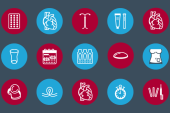As US Abortion Protections Are Lost, Cardiologists Brace for Impact
With Roe v. Wade overturned, decisions for pregnant women with high-risk cardiac conditions could become even more fraught.

|
On Friday, June 24, 2022, the US Supreme Court overturned the Roe v. Wade decision, ending federal abortion protections that have been in place for nearly 50 years. TCTMD is reposting this story, originally published on May 13, 2022, that examines how the fallout will affect the cardiology community. |
Leaked Supreme Court documents that may foretell the loss of federal abortion protections in the United States have been making headlines around the globe—they also have profound implications for cardiovascular care.
If the draft opinion from the US Supreme Court, obtained by Politico earlier this month, becomes final, the issue will likely be kicked back to the individual states to legislate as they see fit. The resulting patchwork of abortion laws will drastically affect the options available and influence discussions between patients and doctors about pregnancy termination, which is considered or advised for women with a range of cardiac conditions that place them at extremely high risk for poor outcomes if they proceed. Termination is also considered for a fetus found to have a severe congenital heart defect, for instance, that is incompatible with life.
Mary Norine Walsh, MD (Ascension St. Vincent Heart Center, Indianapolis, IN), a past president of the American College of Cardiology, oversees some patients with high-risk cardiovascular conditions as they navigate decisions around pregnancy.
The best example of this type of situation from the world of heart failure, she said, is a woman who has had a previous pregnancy affected by peripartum cardiomyopathy. If guideline-directed medical therapy doesn’t lead to recovery of LV systolic function, the risk of severe morbidity or death during a subsequent pregnancy remains very high, and in this situation, contraception is recommended to prevent another pregnancy, Walsh told TCTMD. Then, if LV systolic function eventually recovers, risks are discussed again.
If this type of patient finds herself pregnant unintentionally, Walsh said, “it’s a tough conversation to have about the choice between pregnancy termination and continuing with a very high-risk pregnancy, but it’s one that we have not infrequently.”
Layer in the complex care required for congenital heart disease and severe pulmonary hypertension in which cardiologists are often involved and those heartbreaking discussions become even more sensitive. Loss of protections for abortion access complicate those even further, said Jennifer Haythe, MD, director of the cardio-obstetrics program at NewYork-Presbyterian/Columbia University Irving Medical Center, New York, NY, stressing that “my belief is that women should have the right to choose for any reason.”
Abortion as Essential Care
Abortion access has long been a controversial and polarizing issue in the United States. Federal protections have existed since January 1973, under the precedent set by the US Supreme Court’s Roe v. Wade decision. But now, a draft opinion on the Dobbs v. Jackson Women’s Health case indicates those protections are at risk, as elaborated on in an issue brief from the Kaiser Family Foundation.
I think that the idea that more women will die is a real one, and for reasons that are totally unnecessary. Jennifer Haythe
If the decision is finalized and Roe v. Wade is overturned, that will likely return the issue to the states. As noted by the Guttmacher Institute, 23 states currently have laws, either already on the books or ready to be triggered by the overturning of Roe v. Wade, that could be used to severely restrict abortion within their borders, whereas another 16 states and the District of Columbia have laws protecting the right to have an abortion.
The fraught political landscape doesn’t jibe with the medical stance on abortion, with the American College of Obstetricians and Gynecologists (ACOG) calling it “essential healthcare.”
A lot of work has been done in recent years on the link between maternal mortality and CVD, and there are guidelines on the management of pregnant women with CVD, said Afshan Hameed, MD (University of California, Irvine), a member of the task force behind ACOG’s guidance on pregnancy and heart disease. “In literally every single guideline or instruction for care of such women, there are certain conditions where a recommendation is to not continue with the pregnancy because the risk to the mother is so high,” she said.
Indeed, both a 2017 scientific statement on the management of pregnancy in patients with complex congenital heart disease from the American Heart Association (AHA) and ACOG’s guidance refer to a modified World Health Organization (WHO) classification scheme to identify women who carry such a higher risk of mortality or morbidity that pregnancy is not advised (WHO class IV). This category includes women with pulmonary arterial hypertension; severe systemic ventricular dysfunction (LVEF < 30% or NYHA class III or IV heart failure); previous peripartum cardiomyopathy with any residual impairment of LV function; severe mitral stenosis or severe symptomatic aortic stenosis; Marfan syndrome and aortic dilation > 45 mm; aortic dilation > 50 mm in bicuspid aortic valve aortopathy; and native severe coarctation.
“These patients should be counseled to avoid pregnancy. If pregnancy is confirmed in a woman in WHO class IV, then termination is advised,” the AHA document states.
For patients with these types of conditions, Hameed explained, pregnancy can cause changes in the body that push them into dangerous territory, even if they’ve been well controlled with medications and modifications to physical activity. “What happens with pregnancy is that the heart, the cardiovascular system, is significantly stressed,” she said, likening it to putting somebody on a treadmill for the duration of the pregnancy.
In addition, another AHA scientific statement on the diagnosis and treatment of fetal cardiac disease advises discussing termination of pregnancy as an option after a diagnosis of prenatal congenital heart disease is made, with the conversation covering potential restrictions based on timing or legal limits. And it puts decision-making squarely in the hands of the patients, noting: “Counselors should refrain from imposing personal bias into the discussion and should strive for the goal of providing families with all of the tools and support necessary to come to a decision that is best suited for them.”
Intruding on the Patient-Physician Discussion
The physicians interviewed by TCTMD said the information provided to women with underlying cardiac conditions about the risks associated with pregnancy won’t necessarily change if federal abortion protections are lost, but there could be an impact on what happens after a woman has made her decision.
“From a cardiovascular practice standpoint, the responsibility that we have is to ensure that pregnant patients know what their risks are [so they can] make their own decisions, and what I would say is this will just complicate that decision for women in many states,” Walsh said, adding that “that secondary decision is truly a woman’s own to make.”
In literally every single guideline or instruction . . . there are certain conditions where a recommendation is to not continue with the pregnancy because the risk to the mother is so high. Afshan Hameed
Speaking on behalf of the Society for Maternal-Fetal Medicine, Cara Heuser, MD (University of Utah, Salt Lake City), an expert on high-risk pregnancies, said, “Right now, with there being broad protection for pregnancy termination, we’re able to really counsel people as to when they get pregnant with some of these high-risk conditions what their maternal risks might be, what their fetal risks might be, and then have a nuanced conversation and explore all options with them. And they get to make a decision after they weigh all of those risks and benefits. But once abortion legislation goes back to the state level, it will very much depend on how individual state laws are written.”
And those state laws are not compatible with the complexities of how decisions around pregnancy termination are made, Heuser said. Some of the existing laws restricting abortion in certain states contain exceptions, using phrases like “medical emergency” or “life-threatening situation.” However, those are vague terms, Heuser said. “The laws presume a certainty that is at odds with clinical medicine.”
For example, how great does the risk of death for the mother have to be to justify abortion under that type of law—5%, 10%, 40%, or 100%? Heuser asked. “It takes that nuance out of those discussions that should be between a patient and their physician and whoever their support people are to allow them to explore that nuance and make their own decision.”
If federal protection of abortion access is lost, Hameed said, it’ll be even more important to have discussions about sexuality, pregnancy, and prevention of pregnancy, because if a woman becomes pregnant unexpectedly and would otherwise have been recommended for termination, “your hands are going to be tied.”
Walsh said, “Will we be in situations where physicians are actually providing information about surrounding states and their options to women? That may happen.”
She and others noted that even if a neighboring state is an option for obtaining an abortion, not all women have the means to travel that far for medical care. Some may choose to stay put and explore unsafe, illegal options that can put them at risk for infection, hemorrhage, future infertility, and death, Haythe noted.
There are concerns, also, Haythe said, about how far some state laws will go in trying to prevent female residents from getting an abortion—whether citizens will be able to sue individuals in other states that help facilitate an abortion, whether medications used to induce abortion will be able to be shipped across state lines, and whether women will be charged with murder for terminating a pregnancy. If Roe v. Wade is ultimately overturned, “it’s going to create a lot of confusion,” Haythe said.
An Uptick in Maternal Mortality?
Aside from potential legal complications, the loss of broad protections for abortion is likely to have a real impact on maternal mortality rates, which have been increasing in the United States over the past several decades and are much higher compared with other developed nations. Of note, numbers from the US Centers for Disease Control and Prevention show that the leading cause of pregnancy-related death in the country is cardiovascular disease.
“I think that we are absolutely going to see a rise in the already relatively high maternal morbidity and mortality rates in the United States,” Heuser predicted if Roe v. Wade falls. “We will have patients who have underlying medical conditions that are borderline safe for pregnancy but that we can’t unequivocally say are medical emergencies who may not be able to seek care in another state.”
Forcing women to carry to term pregnancies that are not viable is just appalling and abhorrent. Mary Norine Walsh
Heuser noted that there are already worse maternal outcomes among patients from racial/ethnic minority groups, “and it’s possible that that health disparity could worsen.”
Walsh agreed with Heuser’s assessment. If women are more likely to carry to term pregnancies that are considered high risk, “this may well influence our state-by-state maternal cardiovascular mortality rates that we’ve been keeping such a close eye on,” she said. “The concern would be that states with limitations would see an increase in maternal mortality.”
There may be psychological effects as well. When a fetus is nonviable for any reason, women are offered dilation and curettage to terminate the pregnancy, but depending on what a particular state’s restrictions look like, women may be forced to carry these pregnancies to term, Walsh said. “Forcing women to carry to term pregnancies that are not viable is just appalling and abhorrent.”
And the implications of a loss of abortion access stretch beyond pregnancy itself, as parents may be forced into a situation where they’re providing care for a child born with severe disabilities stemming from a congenital heart defect, for example, but aren’t prepared to do so, Haythe said.
“For people whose contraception fails or who make a mistake or for whatever reason get pregnant and it’s not something they want or it’s not safe, it’s going to be much more challenging, and so it’s going to endanger the lives of those women for sure,” Haythe said. “And it’s going to result in a lot of emotional trauma for women who have to carry fetuses that have congenital heart disease and don’t have the resources to support those children. And it’s not clear to me that the government has any plan to put into action any laws to protect those children and the parents having them to support them through that.”
In the context of this discussion, Heuser stressed the importance of providing clear information to patients about pregnancy and its associated risks, noting that sometimes when physicians tell women they “can’t get pregnant,” they mean they “shouldn’t get pregnant,” a miscommunication that could result in ill-advised pregnancies.
“How we communicate with patients and how we talk about their reproductive lives is also really important even if you’re not a doctor that always does reproductive care,” Heuser said. “I think that reproductive life planning should be part of all medical care and especially care of underlying serious medical conditions, and that’s probably something that we could ask our cardiology colleagues to help us with and refer people who have serious underlying medical conditions to us sooner, so that we can have these conversations with them ahead of time.”
Ultimately, if Roe v. Wade is overturned, Haythe predicted, “I think it will unfortunately not necessarily change the number of abortions that happen. It will just make them more unsafe. It will isolate poor, socioeconomically disadvantaged, and minority populations specifically. And so I think it’s going to be a terrible thing for the country. I think that the idea that more women will die is a real one, and for reasons that are totally unnecessary.”
Todd Neale is the Associate News Editor for TCTMD and a Senior Medical Journalist. He got his start in journalism at …
Read Full Bio




Comments